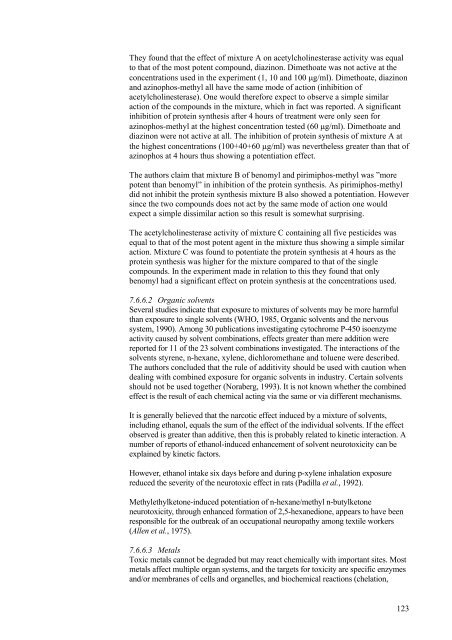Combined Actions and Interactions of Chemicals in Mixtures
Combined Actions and Interactions of Chemicals in Mixtures
Combined Actions and Interactions of Chemicals in Mixtures
Create successful ePaper yourself
Turn your PDF publications into a flip-book with our unique Google optimized e-Paper software.
They found that the effect <strong>of</strong> mixture A on acetylchol<strong>in</strong>esterase activity was equal<br />
to that <strong>of</strong> the most potent compound, diaz<strong>in</strong>on. Dimethoate was not active at the<br />
concentrations used <strong>in</strong> the experiment (1, 10 <strong>and</strong> 100 µg/ml). Dimethoate, diaz<strong>in</strong>on<br />
<strong>and</strong> az<strong>in</strong>ophos-methyl all have the same mode <strong>of</strong> action (<strong>in</strong>hibition <strong>of</strong><br />
acetylchol<strong>in</strong>esterase). One would therefore expect to observe a simple similar<br />
action <strong>of</strong> the compounds <strong>in</strong> the mixture, which <strong>in</strong> fact was reported. A significant<br />
<strong>in</strong>hibition <strong>of</strong> prote<strong>in</strong> synthesis after 4 hours <strong>of</strong> treatment were only seen for<br />
az<strong>in</strong>ophos-methyl at the highest concentration tested (60 µg/ml). Dimethoate <strong>and</strong><br />
diaz<strong>in</strong>on were not active at all. The <strong>in</strong>hibition <strong>of</strong> prote<strong>in</strong> synthesis <strong>of</strong> mixture A at<br />
the highest concentrations (100+40+60 µg/ml) was nevertheless greater than that <strong>of</strong><br />
az<strong>in</strong>ophos at 4 hours thus show<strong>in</strong>g a potentiation effect.<br />
The authors claim that mixture B <strong>of</strong> benomyl <strong>and</strong> pirimiphos-methyl was ”more<br />
potent than benomyl” <strong>in</strong> <strong>in</strong>hibition <strong>of</strong> the prote<strong>in</strong> synthesis. As pirimiphos-methyl<br />
did not <strong>in</strong>hibit the prote<strong>in</strong> synthesis mixture B also showed a potentiation. However<br />
s<strong>in</strong>ce the two compounds does not act by the same mode <strong>of</strong> action one would<br />
expect a simple dissimilar action so this result is somewhat surpris<strong>in</strong>g.<br />
The acetylchol<strong>in</strong>esterase activity <strong>of</strong> mixture C conta<strong>in</strong><strong>in</strong>g all five pesticides was<br />
equal to that <strong>of</strong> the most potent agent <strong>in</strong> the mixture thus show<strong>in</strong>g a simple similar<br />
action. Mixture C was found to potentiate the prote<strong>in</strong> synthesis at 4 hours as the<br />
prote<strong>in</strong> synthesis was higher for the mixture compared to that <strong>of</strong> the s<strong>in</strong>gle<br />
compounds. In the experiment made <strong>in</strong> relation to this they found that only<br />
benomyl had a significant effect on prote<strong>in</strong> synthesis at the concentrations used.<br />
7.6.6.2 Organic solvents<br />
Several studies <strong>in</strong>dicate that exposure to mixtures <strong>of</strong> solvents may be more harmful<br />
than exposure to s<strong>in</strong>gle solvents (WHO, 1985, Organic solvents <strong>and</strong> the nervous<br />
system, 1990). Among 30 publications <strong>in</strong>vestigat<strong>in</strong>g cytochrome P-450 isoenzyme<br />
activity caused by solvent comb<strong>in</strong>ations, effects greater than mere addition were<br />
reported for 11 <strong>of</strong> the 23 solvent comb<strong>in</strong>ations <strong>in</strong>vestigated. The <strong>in</strong>teractions <strong>of</strong> the<br />
solvents styrene, n-hexane, xylene, dichloromethane <strong>and</strong> toluene were described.<br />
The authors concluded that the rule <strong>of</strong> additivity should be used with caution when<br />
deal<strong>in</strong>g with comb<strong>in</strong>ed exposure for organic solvents <strong>in</strong> <strong>in</strong>dustry. Certa<strong>in</strong> solvents<br />
should not be used together (Noraberg, 1993). It is not known whether the comb<strong>in</strong>ed<br />
effect is the result <strong>of</strong> each chemical act<strong>in</strong>g via the same or via different mechanisms.<br />
It is generally believed that the narcotic effect <strong>in</strong>duced by a mixture <strong>of</strong> solvents,<br />
<strong>in</strong>clud<strong>in</strong>g ethanol, equals the sum <strong>of</strong> the effect <strong>of</strong> the <strong>in</strong>dividual solvents. If the effect<br />
observed is greater than additive, then this is probably related to k<strong>in</strong>etic <strong>in</strong>teraction. A<br />
number <strong>of</strong> reports <strong>of</strong> ethanol-<strong>in</strong>duced enhancement <strong>of</strong> solvent neurotoxicity can be<br />
expla<strong>in</strong>ed by k<strong>in</strong>etic factors.<br />
However, ethanol <strong>in</strong>take six days before <strong>and</strong> dur<strong>in</strong>g p-xylene <strong>in</strong>halation exposure<br />
reduced the severity <strong>of</strong> the neurotoxic effect <strong>in</strong> rats (Padilla et al., 1992).<br />
Methylethylketone-<strong>in</strong>duced potentiation <strong>of</strong> n-hexane/methyl n-butylketone<br />
neurotoxicity, through enhanced formation <strong>of</strong> 2,5-hexanedione, appears to have been<br />
responsible for the outbreak <strong>of</strong> an occupational neuropathy among textile workers<br />
(Allen et al., 1975).<br />
7.6.6.3 Metals<br />
Toxic metals cannot be degraded but may react chemically with important sites. Most<br />
metals affect multiple organ systems, <strong>and</strong> the targets for toxicity are specific enzymes<br />
<strong>and</strong>/or membranes <strong>of</strong> cells <strong>and</strong> organelles, <strong>and</strong> biochemical reactions (chelation,<br />
123

















